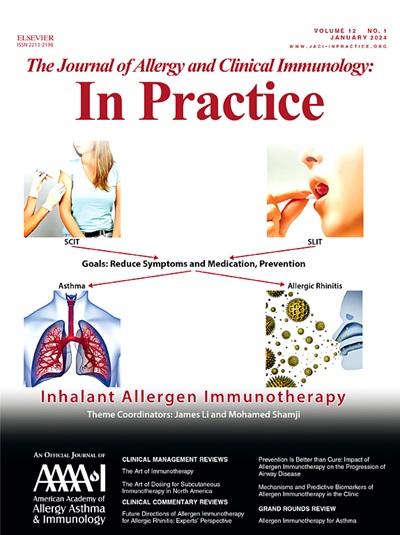多尼达洛森治疗长期预防的遗传性血管性水肿患者。
IF 6.6
1区 医学
Q1 ALLERGY
Journal of Allergy and Clinical Immunology-In Practice
Pub Date : 2025-09-01
DOI:10.1016/j.jaip.2025.06.018
引用次数: 0
摘要
背景:遗传性血管性水肿(HAE)是一种罕见的、潜在危及生命的疾病,其特征是组织肿胀发作。Donidalorsen是一种研究中的配体共轭反义寡核苷酸,可减少血浆前钾likin的产生。目的:我们报告一项正在进行的开放标签3期研究(OASISplus Switch队列,NCT05392114)的安全性、有效性、生活质量(QoL)、治疗偏好和满意度的中期分析。方法:接受稳定剂量(≥12周)lanadelumab、补体蛋白1抑制剂或贝曲司他治疗的HAE患者,使用预定义算法,每4周皮下注射donidalorsen 80mg。主要终点是治疗中出现的不良事件的发生率和严重程度。其他终点包括HAE发作率、血管性水肿-生活质量评分、疾病控制(血管性水肿控制试验≥10分)的变化,以及第16周与先前治疗基线相比的治疗偏好和满意度。结果:共纳入65例患者;32人改用lanadelumab, 22人改用补体蛋白1抑制剂,11人改用贝曲司他。截止时,58人仍在研究中(89%)。45名患者(70%)报告了治疗后出现的不良事件;62%的患者与牙周炎无关。在第16周,HAE总发病率下降了62%。遗传性血管性水肿发作率降低了65%、41%和73%,从lanadelumab、C1INH和贝曲司他切换的患者的平均血管性水肿-生活质量评分分别提高了8.4、9.6和17.1分。更多的患者报告疾病控制良好(93% vs 67%),大多数患者比之前的治疗更喜欢多尼洛森,治疗满意度提高。结论:多尼洛森耐受性良好,降低HAE发作率,改善生活质量和疾病控制。与之前的治疗相比,大多数患者更喜欢多尼洛森。计划在第52周进行进一步分析。本文章由计算机程序翻译,如有差异,请以英文原文为准。
Donidalorsen Treatment of Hereditary Angioedema in Patients Previously on Long-Term Prophylaxis
Background
Hereditary angioedema (HAE) is a rare, potentially life-threatening disorder characterized by episodes of tissue swelling. Donidalorsen, an investigational ligand-conjugated antisense oligonucleotide, reduces plasma prekallikrein production.
Objective
We report an interim analysis on safety, efficacy, quality of life (QoL), and treatment preference and satisfaction from an ongoing open-label phase 3 study (OASISplus Switch cohort, NCT05392114).
Methods
Patients with HAE receiving stable doses (≥12 weeks) of lanadelumab, complement protein 1 inhibitor, or berotralstat switched to donidalorsen 80 mg subcutaneously every 4 weeks, using a predefined algorithm. The primary end point was the incidence and severity of treatment-emergent adverse events. Other end points included change in HAE attack rate, angioedema-QoL score, disease control (≥10 points on the Angioedema Control Test), and treatment preference and satisfaction at week 16, compared with baseline on prior treatment.
Results
A total of 65 patients were enrolled; 32 switched from lanadelumab, 22 from complement protein 1 inhibitor, and 11 from berotralstat. At cutoff, 58 were ongoing in the study (89%). Forty-five patients (70%) reported treatment-emergent adverse events; 62% were unrelated to donidalorsen. At week 16, total HAE attack rates had decreased by 62%. Hereditary angioedema attack rates decreased by 65%, 41%, and 73%, and mean angioedema-QoL scores improved by 8.4, 9.6, and 17.1 points for patients switching from lanadelumab, C1INH, and berotralstat, respectively. More patients reported well-controlled disease (93% vs 67%), and most patients preferred donidalorsen over their prior treatment, with improved treatment satisfaction.
Conclusions
Donidalorsen was well tolerated, decreased HAE attack rate, and improved QoL and disease control. Most patients preferred donidalorsen over their prior treatment. Further analyses are planned at week 52.
求助全文
通过发布文献求助,成功后即可免费获取论文全文。
去求助
来源期刊

Journal of Allergy and Clinical Immunology-In Practice
ALLERGYIMMUNOLOGY-IMMUNOLOGY
CiteScore
11.10
自引率
9.60%
发文量
683
审稿时长
50 days
期刊介绍:
JACI: In Practice is an official publication of the American Academy of Allergy, Asthma & Immunology (AAAAI). It is a companion title to The Journal of Allergy and Clinical Immunology, and it aims to provide timely clinical papers, case reports, and management recommendations to clinical allergists and other physicians dealing with allergic and immunologic diseases in their practice. The mission of JACI: In Practice is to offer valid and impactful information that supports evidence-based clinical decisions in the diagnosis and management of asthma, allergies, immunologic conditions, and related diseases.
This journal publishes articles on various conditions treated by allergist-immunologists, including food allergy, respiratory disorders (such as asthma, rhinitis, nasal polyps, sinusitis, cough, ABPA, and hypersensitivity pneumonitis), drug allergy, insect sting allergy, anaphylaxis, dermatologic disorders (such as atopic dermatitis, contact dermatitis, urticaria, angioedema, and HAE), immunodeficiency, autoinflammatory syndromes, eosinophilic disorders, and mast cell disorders.
The focus of the journal is on providing cutting-edge clinical information that practitioners can use in their everyday practice or to acquire new knowledge and skills for the benefit of their patients. However, mechanistic or translational studies without immediate or near future clinical relevance, as well as animal studies, are not within the scope of the journal.
 求助内容:
求助内容: 应助结果提醒方式:
应助结果提醒方式:


